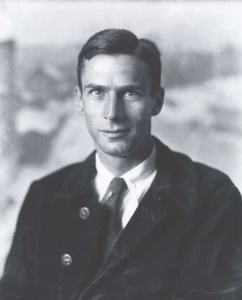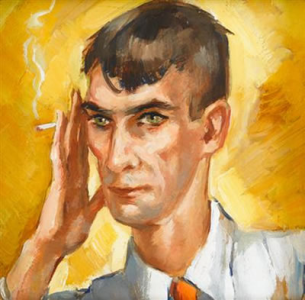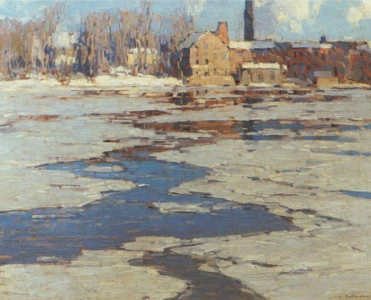

Biography
John Fulton Folinsbee was born in Buffalo, NY in 1892. He attended the Art Students League in Buffalo at age 11 before his family moved to Boston. At age 14 Folinsbee contracted polio, which paralyzed his legs and weakened one of his arms. This required him to use a wheelchair for the rest of his life.
In 1907 Folinsbee studied with the landscape painter Jonas Lie in New Jersey, getting his first introduction to plein air painting, an approach he would enthusiastically adopt. From 1907-1911 he attended the Gunnery School in Washington, CT, where he benefited from the presence of a small artists' colony in the town. He studied with Elizabeth Kempton, who encouraged him to pursue art as a career, and with the painters Herbert Faulkner and Henry Siddons Mowbray. He also met Frank Dumond, with whom he was later to study at the Art Students League in New York (ASL).
Ruth Baldwin, whom Folinsbee was later to marry, gave him a copy of L. Birge Harrison's Landscape Painting. This book, and Harrison's lectures at Woodstock, where Folinsbee studied in the summers of 1912-1914, turned Folinsbee's primary interest from portrait painting to landscapes. Folinsbee spent two summers as a student at Woodstock, working with Harrison and John Carlson, and one summer sharing a studio with Harry Leith-Ross, who became a lifelong friend.
In the winter of 1912-1913 Folinsbee attended classes at the ASL. The following year Harrison invited Folinsbee and Leith-Ross to spend the winter in Woodstock, and in 1914, Folinsbee was back at ASL, studying with Frank Dumond. Around this time Folinsbee's career and personal life began to flourish. His "Morning Light" accepted for exhibition at the National Academy of Design in 1913; he was accepted as a member of the Salmagundi Club the same year; and he married Ruth Baldwin in 1914. Ruth was the daughter of railroad tycoon William Henry Baldwin, Jr. and Ruth Standish Baldwin. Her mother was a very impressive woman, a suffragist, co-founder of the National Urban League, trustee of Smith College and, later in life, a co-founder of The Highlander Folk School.
In 1916 Folinsbee won the Third Hallgarten Prize of the National Academy of Design for his "Winter Quiet," and the Hillyer Gallery at Smith College hosted his first solo show. Around this time Folinsbee and his wife moved to New Hope, PA, joining an active art colony, where Folinsbee's work fitted in nicely with that of the other Pennsylvania Impressionists. The couple had two children, Elizabeth (b.1917) and Joan (b.1919). Beginning in 1917, Folinsbee was represented by the Ferargil Gallery in New York, where he held solo shows almost every year.
He became an associate member of the National Academy in 1919 and received the Isadore Prize from the Salmagundi Club in 1920. He was named a life member of the National Arts Club in 1921 and helped found the Grand Central Art Galleries in New York in 1923. He built a house on the Delaware River in 1924, providing an excellent viewpoint for the landscapes he loved to paint.
In 1926 Folinsbee traveled to England and France, where he deepened his understanding of Cézanne's works. A group of his paintings was shown at the Carnegie International in Pittsburgh in 1929. The same year he helped found Phillips' Mill, a center for the arts in New Hope, and he became a full academician at the National Academy of Design.
In the 1930s Folinsbee began spending summers in Maine. He received the Sesnan Gold Medal from the Pennsylvania Academy of the Fine Arts in 1931. And, in the depths of the Depression, he returned to portrait painting as a source of income.
In 1937 Folinsbee completed a Post Office mural "Freeland" in Freeland, PA. And he collaborated with his student Peter G. Cook on a mural "The River" for the Paducah, KY Federal Building and U.S. Courthouse. The following year Cook married Folinsbee's daughter Joan. Folinsbee and Cook also collaborated on a Post Office mural for Burgettstown, PA, "View of Burgettstown" (1942). In 1944 Folinsbee won the Grand Central Gallery Landscape Prize.
In 1949 Folinsbee purchased a farmhouse near Wiscasset, ME. He won prizes from the National Academy of Design (the Benjamin Altman Prize, 1950 and the Palmer Marine Prize, 1952) and the Century Association (1951). In 1953 he was named to the American Academy of Arts and Letters. Folinsbee didn't stop painting until he was stricken with cancer in 1971. He died in New Hope in 1972.



Critical Analysis
John Folinsbee's career had three distinct phases: Tonalism, Impressionism, and Expressionism. Tonalism was exemplified by such artists as James McNeill Whistler and George Inness. This style was marked by a focus on atmosphere, using subtle gradations of light and dark. It was popular in America, where such paintings reflected an interest in nature in the face of growing industrialization. Folinsbee's pursuit of tonalism was a natural outgrowth of his studies with Birge Harrison, since Harrison was a prime exponent of this style.
During his first years in New Hope, Folinsbee's style evolved in the direction of Impressionism, which was the dominant mode of the New Hope School. This involved an expanded palette of brighter colors, applied with small but visible brushstrokes. Folinsbee's work was also probably influenced by his teacher Frank Dumond, who developed a color theory known as the "prismatic palette."
Influenced by his study of Cézanne, Folinsbee's style changed again in the late 1920s. His Expressionist work from that period on was characterized by bolder brushstrokes and even brighter colors. This evolution was due, in part, to his time in Maine, where the Expressionist style was perhaps more attuned to the raw environment of the Maine coast. Some Folinbee admirers insist that the "real" Folinsbee was the Pennsylvania Impressionist of the New Hope School, while others prefer the heightened drama of Folinsbee's Expressionist paintings.
Murals
- Paducah, Kentucky - Federal Building and U.S. Courthouse: Early Town
- Paducah, Kentucky - Federal Building and U.S. Courthouse: The River
- Burgettstown, Pennsylvania - Post Office: View of Burgettstown
- Freeland, Pennsylvania - Post Office: Freeland
References
- The John F. Folinsbee Catalogue Raisonné (The John F. Folinsbee Catalogue Raisonné).
- John Folinsbee (Woodmere).
- John Fulton Folinsbee (Wikipedia).
- John Fulton Folinsbee (Vose Galleries).
- John Fulton Folinsbee (Bucks County Artists Database).
- John Fulton Folinsbee (Incollect).
- Jim Lane, John Fulton Folinsbee, Art Now and Then May 15 (2017).